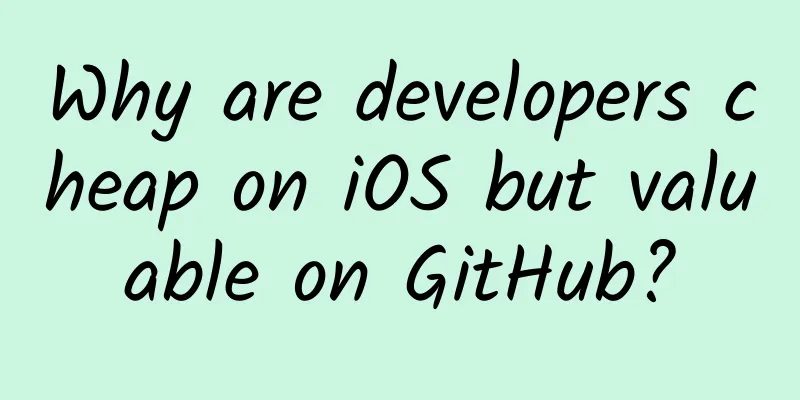Why are developers cheap on iOS but valuable on GitHub?

|
Editor's note: Recently, two major events closely related to developers have occurred, one is Apple's Worldwide Developers Conference (WWDC), and the other is Microsoft's acquisition of GitHub for $7.5 billion. In the view of famous analyst Ben Thompson, this reflects the difference in the cost of acquiring developers on different platforms.
I saw three developer-related announcements recently, two from Apple and one from Microsoft. The former was part of Apple's annual Worldwide Developers Conference keynote:
Meanwhile, Microsoft's second major acquisition in three years overshadowed Apple's developer conference, with the company's press release stating: Microsoft announced on Monday that it has reached an agreement to acquire GitHub, the world's leading software development platform, where more than 28 million developers learn, share, collaborate and create the future together. Together, the two companies will help developers achieve more at every stage of the development lifecycle, accelerate the use of GitHub by enterprises, and bring Microsoft's development tools and services to new audiences. "Microsoft is a developer-first company, and by working with GitHub, we are reinforcing our commitment to developer freedom, openness, and innovation," said Microsoft CEO Satya Nadella. "We recognize the community responsibility we have with this agreement and will do our best to empower every developer to build products, innovate, and solve the world's most pressing problems." Under the terms of the agreement, Microsoft will acquire GitHub for $7.5 billion. See, developers are really valuable (and expensive)! Symbiosis between platform and developers Over the past few weeks, particularly in the Bill Gates Line article, I’ve been exploring the differences between Aggregators and Platforms; Aggregators typically acquire and distribute already produced content or goods, but Developers use platforms to create something entirely new. This results in a symbiotic relationship between developers and platforms: from a technical perspective, the platform provides the basic building blocks (i.e., application programming interfaces, or APIs) that developers need to build new experiences, and from a marketing perspective, these new experiences give consumers a reason to spend money on the platform or upgrade. Of course, applications will vary in the degree to which they drive adoption of the underlying platform; similarly, platforms will vary in their potential for monetization relative to developers. For example, traditional Windows offers very few end-user features; what makes it so valuable is all the applications built on top of its open platform. "Open" here has two meanings: first, Windows APIs are available to anyone; second, developers can establish direct relationships with end users, including payments. This has driven the birth of many large software companies. In 2003, Valve created a platform on Windows: Steam. What Valve realizes is that playing games is only part of the overall consumer experience; the experience of discovering and purchasing games, as well as the installation and upgrade process are also important. In addition, these consumer pain points are also developer pain points; for example, the original impetus for developing Steam was that it was very difficult for players to upgrade games collectively, which is essential for online competitive games. It is worth noting that although Valve is a private company and has never released Steam's revenue figures, there are reports that the platform can generate billions of dollars in revenue each year. Still, that pales in comparison to the iOS App Store: Apple married Steam’s app store philosophy to the platform, leaving iOS users and developers with no choice but to use Apple’s own and operated distribution channels, which come with all sorts of restrictions and costs—30% to be exact. Apple can do this in the first place because the underlying products — the iPhone and iPad — drive demand on their own, independent of the apps. Apple has the users that developers need to make money. Second, like Steam before it, the App Store does have a better experience, which drives more downloads and spending by end users, meaning that developers build apps for iOS not just because of the number of users, but because users across the platform are willing to buy more things. Third, and this also applies to Steam, the App Store significantly lowers the barrier to entry for developers, resulting in more apps, which attract more users, which in turn creates a cycle that results in more apps, both locking in apps as a competitive advantage and ensuring that no single app has too much power (allowing Apple to restrict competitors like Steam through fiat). Apple's platform announcement This is how the two Apple announcements I mentioned above are framed. Let’s start with the $100 billion in iOS developer revenue news: This means Apple has earned about $40 billion in revenue, with a very high profit margin. Moreover, the vast majority of Apple’s announcements, if any, were about competing with these developers: The first new app released was Measure, which should immediately clear the store of the only obviously useful AR app. Apple also announced a new Podcasts app for the Watch, updates to the News, Stocks, and Voice Memos apps, and the only third-party presentation was about a major software company—Adobe—coming to support Apple’s new 3D graphics format. And why not? Having all these high-value users means that developers are cheap on iOS anyway. The Mac is different, though: the platform is much smaller than the iPhone; high-quality independent software vendors supporting the Mac still exist, proving that it is valuable for developers to have direct relationships with consumers that span years and multiple transactions. Still, it seems beyond doubt that the number of Mac apps will not grow in any meaningful way; there simply aren't enough users to attract developers. This means that Apple's approach on the Mac has to be very different from iOS: instead of dictating to developers, Apple announced a project it was working on to make it easier to port iOS apps to the Mac. In a way, this is Apple paying for Mac apps; however, the money is not going to the developer, and Apple is taking on most of the porting work. When you don't have that many users, developers become expensive. Cost of Github Still, whatever it cost Apple to build this porting framework, it was certainly far less than the $7.5 billion that Microsoft paid for GitHub. At first glance, it might not be clear what such a comparison means. Back to Windows: Microsoft had little trouble convincing developers to build apps on the platform. In fact, even at the height of Microsoft's antitrust troubles, developers overwhelmingly supported the platform for one obvious reason: all the users were there. In other words, developers were cheap for Windows. That’s no longer the case: Windows remains an important platform in the enterprise and in gaming (although Steam gets a ton of platform profits there, much to Microsoft’s chagrin), but the company has no platform in mobile and is No. 2 in cloud computing. Moreover, Microsoft’s No. 2 in cloud computing is largely based on steering existing enterprise customers to its own cloud computing services; it’s unclear why new companies or developers would choose Microsoft. This is the context for considering Microsoft's acquisition of GitHub: Lacking a platform with enough users to attract developers, Microsoft had to "acquire" developers directly through more advanced tools. Now, with GitHub, it helps to build a super cloud service with network effects. The problem is that acquiring developers in this way is very expensive without user leverage; it is hard to imagine GitHub generating the kind of revenue that justifies the acquisition price. However, GitHub's revenue is not the point. Microsoft has a lot of revenue. It also has a potential fatal weakness: no user-based platform. Instead, Microsoft believes that open source and cloud-based applications that exist independently of the platform will occupy an increasingly large share in the future, and Microsoft also believes that it has the opportunity to win in the future by providing excellent experiences directly to developers rather than simply influencing them. Incidentally, this is exactly why Microsoft is the acquirer of GitHub, a company that has raised $350 million in venture capital and cannot possibly become a standalone entity. Any platform company with a large number of users will find it difficult to resist the temptation to use GitHub as leverage; on the other hand, purely enterprise-focused companies like IBM or Oracle will be tempted to squeeze every possible profit out of the enterprise. What Microsoft wants is something more ambiguous: It wants to be a friend to developers, in large part because it has no other choice. In the long run, especially as Windows continues to decline, the company will invest more in a field without gatekeepers, where developer tools and cloud computing win on merit rather than by being able to exploit users. However, this is exactly why Microsoft had to pay so much: buying directly is much more expensive than using user leverage, which can produce equal or even better results with less investment! |
<<: A comprehensive summary of mobile UI design specifications
>>: Apple's chief software engineer: Why iOS and macOS will never merge
Recommend
Does increasing the volume of information flow advertising really require piling up a large number of accounts and plans?
In the information flow advertising industry, who...
12 strategies for product marketing promotion, do you know how to use them?
Only when doing business with you becomes the cus...
2016 China APP Category Ranking
In 2016, competition in the mobile Internet arena...
Lin Bin: Xiaomi's Four Principles for Becoming a "Hot-selling E-commerce Company"
A few days ago, I attended an economic forum in C...
2021 Tik Tok Hot-selling Live Broadcast Room Creation Plan Course
2021 Tik Tok Hot-selling Live Broadcast Room Crea...
What skills does a SEO manager need? SEO supervisor shares management experience!
Feng Chao from Dongguan has been engaged in SEO w...
Advertising creativity is highly homogenized. How can we break the deadlock?
What should we do if our creative ideas become ho...
100,000+? It is better to take these three steps to directly improve the conversion rate of copywriting!
"100,000+" is a high ground that countl...
Exclusive interview with BroadLink's Liu Zongru: Let intelligence change people's minds
[[121352]] As the current wave of smart hardware ...
8 trends in brand IP marketing in 2020
Looking back at 2019, various popular IP content ...
No cough or fever, but both lungs are white! Who is prone to this? Pay attention to 3 warning signs——
Recently, topics related to "white lung"...
Fermentation makes food full of "magic", what kind of process is this?
Fermentation is nature's "magic". I...
Can anti-blue light glasses protect your eyes and prevent myopia? Attention! Not everyone is suitable for wearing them...
Expert of this article: Li Zongou, Master of Opht...
Is it easy to gain weight as you age? Is there an "age cutoff" for gaining weight? Learn more in this article →
Obesity has become a global public health problem...
Weighing 49 grams! Is this a base layer or outer wear?
Today, let’s get to know Plain yarn single dress ...









